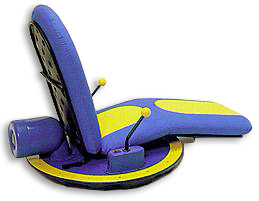BETTER THAN WHEELS
"Better Than Wheels" ponders potential wheelchair alternatives on the horizon and beyond. These ponderances are not limited to alternative devices that could replace wheelchairs, but may also include selected topics relevant to curative objectives.
Wheelchair Alternatives - The Future
 hile
Eugene Roddenberry's Star Trek series may have suggested that
the successors of today's wheelchairs would be high-tech chairs with wheels,
a survey of present-day technologies suggests additional possibilities.
hile
Eugene Roddenberry's Star Trek series may have suggested that
the successors of today's wheelchairs would be high-tech chairs with wheels,
a survey of present-day technologies suggests additional possibilities.
For example, Japan's KIDStudio produced what it called an indoor Hoverchair for handicapped children. While the mobility gained by using this type of hoverchair is quite restricted with respect to terrain, relevant concepts found in devices like jetbelts and the M200G could one day be used to make a remarkably mobile hoverchair.

Another departure from wheelchairs with wheels could involve wheelchairs with legs - walking chairs. Takanishi Laboratory's Waseda Leg, Hubo Lab's HUBO FX-1, and Toyota's i-foot are walking chair prototypes that exist today.

It is entirely conceivable that a future mobility solution could allow some otherwise wheelchair-bound persons to abandon the chair completely. In this case, the potential wheelchair alternative is not something that one sits in but something that one wears - an exoskeleton. Developments like Kanagawa Institute of Technology's Wearable Power Assist Suit, Cyberdyne's HAL, and Berkeley Robotics Laboratory's BLEEX have already demonstrated that a powered exoskeleton is a feasible, future possibility for some otherwise wheelchair-bound people.

Indeed, traditional wheelchair designs are already being experimentally challenged by non-wheeled alternatives today. WheelchairX anticipates a more mobile future for those who would otherwise require a wheelchair.
